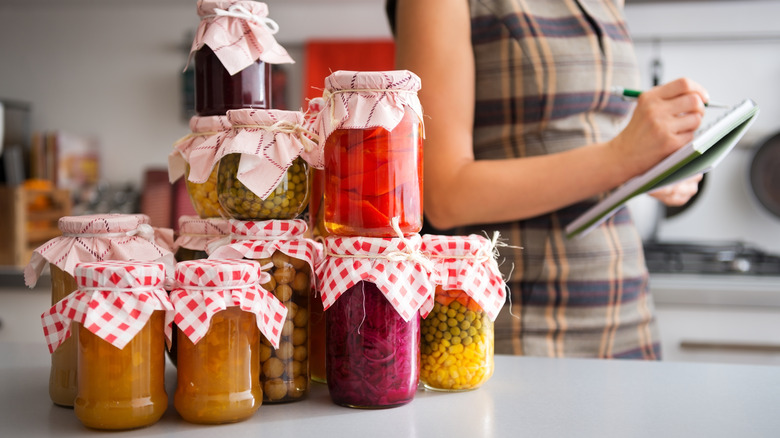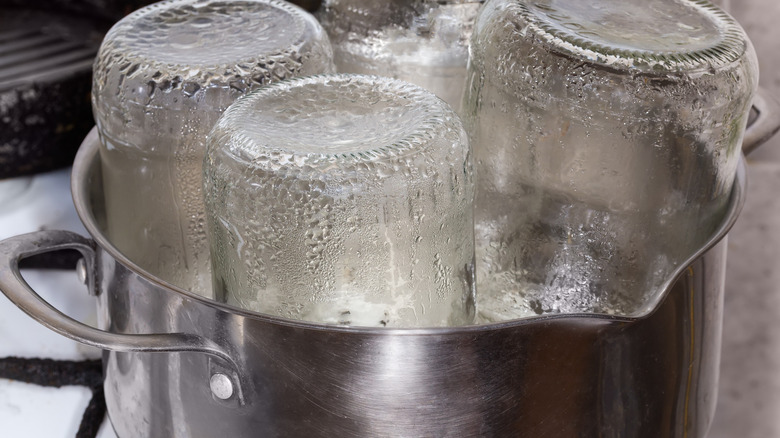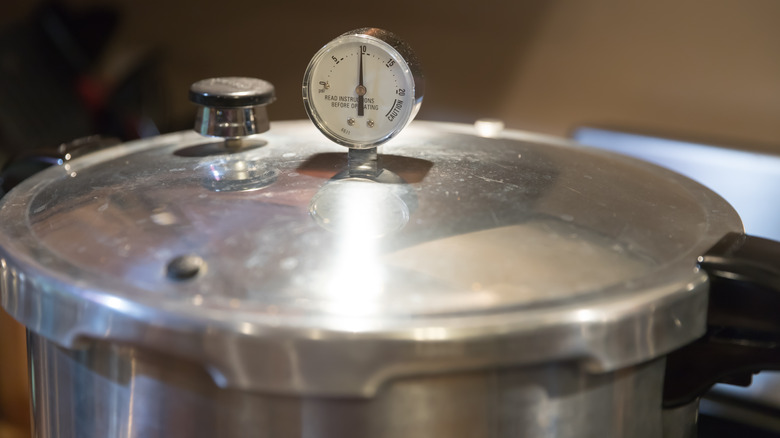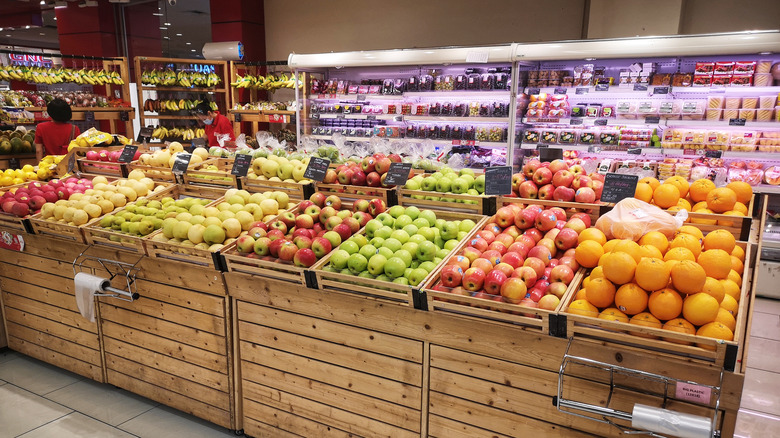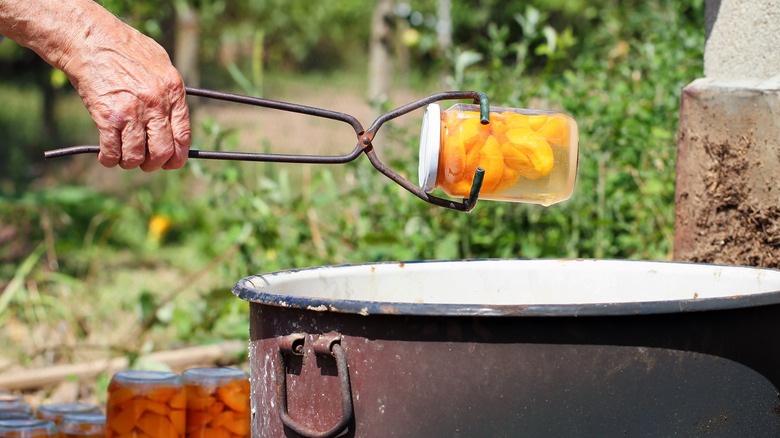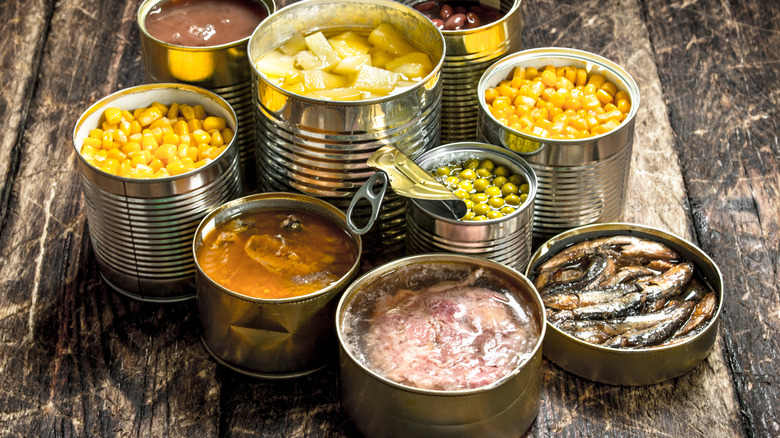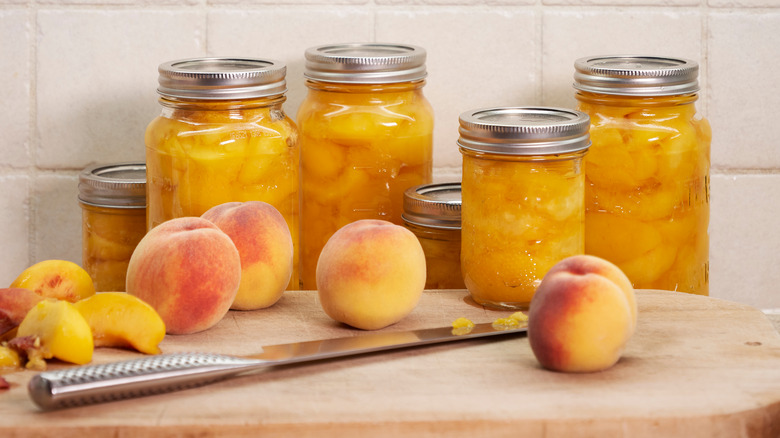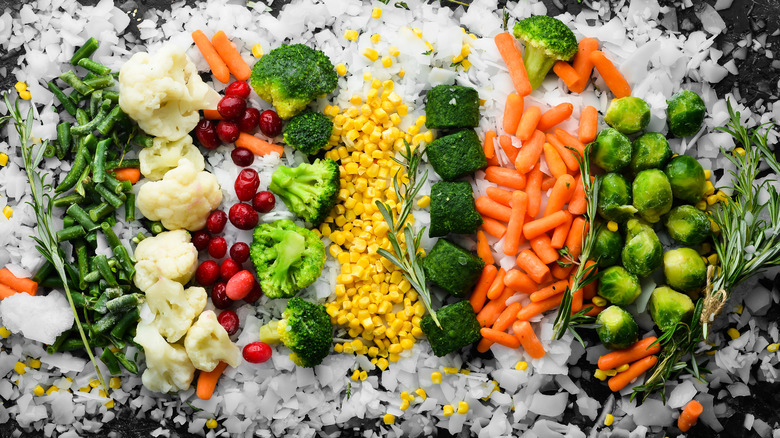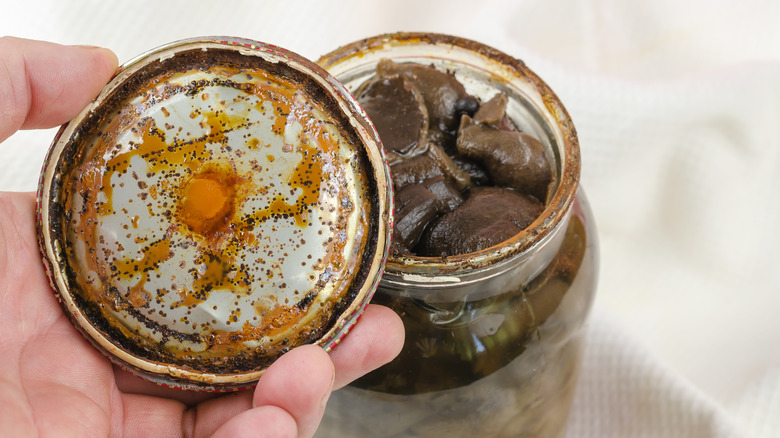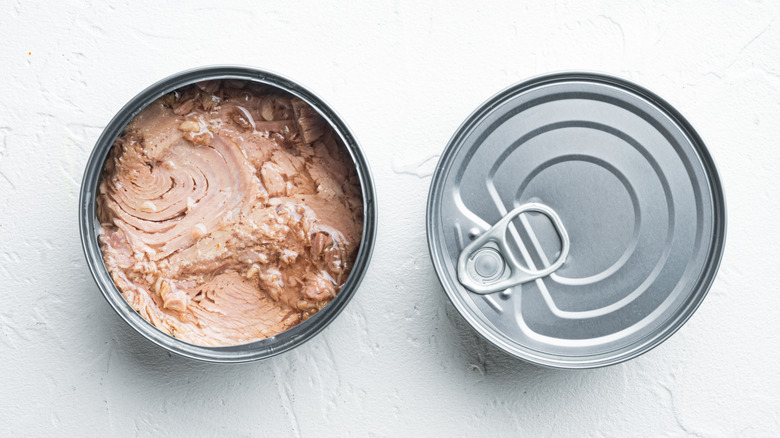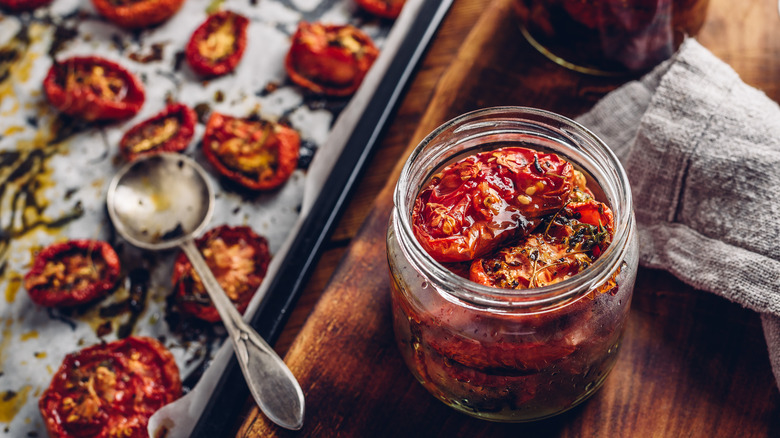Is Home Canning Still Cost-Effective In 2022?
According to the International Food Additives Council, modern canning goes back to the time of Napoleon, but canning foods at home took off in the 1950s when John Landis Mason patented the lidded, hermetically-sealed jar. The preservation practice has seen a resurgence in the last few years as people began spending more time in the kitchen during the COVID-19 pandemic. Many people have started gardening and picking up other self-sufficiency hobbies — canning being one of them. High food prices and inflation have only made home canning more appealing. With all sorts of recipes and equipment available, home canning is certainly more accessible than ever. The question is, though, is home canning still cost-effective in 2022?
We'll be breaking down the basics of what you need to can and the costs of those items. Then, we'll compare home-canned goods to store-bought, as well as some tips and tricks to keep costs down. You should be equipped with the knowledge to decide whether home canning is affordable, and with that in mind, we've collected the data you need to make that decision.
What do you need to can?
Before cost analysis, let's cover what supplies canning requires. For home canning, you don't need cans — you need jars, says Better Homes & Gardens. There are different options available, the main difference being size. Canning jars typically come in 4-ounce, ½-pint, 1-pint, and 1-quart volumes. Since you're going to be using heat, canning jars must be tempered. Tempered glass is crafted through a special process. It's four times stronger than regular glass, and, if it does break, it doesn't shatter into dangerous shards (via Scientific American). Besides being made of tempered glass, the jars must have mouths with a threaded finish. This finish lets the lid seal tightly, preventing your food from spoiling. Jars come in regular- and wide-mouth options. The former is usually used for sauces and jams, while the latter is used for anything that comes in larger pieces.
Next, you must purchase lids and screw bands. The lids aren't reusable; you can only reuse the screw bands if they're not damaged. You'll also need either a water-bath canner or a pressure canner to do the actual canning. Additionally, a jar lifter and funnel help you during the process. Two nonessential but helpful tools are a canning spatula and a magnetic lid wand, which help make the process more exact. The cost of canning supplies ranges depending on the brand. It's a good idea to consider your budget and be realistic about how often you anticipate canning before purchasing supplies.
How much do supplies cost and where do you get them?
Where do you find your canning tools? Most kitchen supply or hardware stores carry the supplies you'll need. It's also easy to find everything online. You can purchase items individually, or you may find many essentials sold together in pre-assembled canning kits, such as this one from the canning company Ball. This is the more affordable option. For example, most canning supply kits on Amazon, which contain the accessories you need, run between $10 and $30. Some kits even include jars.
The actual canning apparatus itself, unfortunately, isn't very cheap. A water bath canner is usually under $100. Most pressure canners are in the $100 to $150 range, so they are more of an investment. There are differences between water bath canning and pressure canning, including the time each method takes and what you might preserve with either process. In terms of cost, water bath canning may be a better method to use when starting out unless your heart is set on canning low-acid items that require pressure. The price of canning jars varies by size, but make sure you buy ones with the correct lids and screw bands; otherwise, you won't be able to use them for canning, and your money will have gone to waste. In terms of supply costs, whether canning is cost-effective depends on how often you end up canning. The materials are an investment but worth it if this becomes a long-term hobby.
How much does produce cost?
Having canning supplies is great, but they'll be worth nothing if you don't have anything to can. While it's possible to can meat, preserving fruits and vegetables is a popular choice. And while produce is generally more affordable than meat, it's still more expensive nowadays. According to the U.S. Bureau of Labor Statistics, food prices were up 9% in June from the previous year. However, there are some simple ways to decrease your budget.
According to Common Health, eating seasonally is key. You can try starting a home garden and canning the fruits of your labor. Or perhaps, your friends have grown more produce than they can handle. Another option is to shop at local farmer's markets or a "pick-your-own" farm. Even if none of these options are available, you can help stave off prices by knowing the seasonality of vegetables.
When vegetables are in season, stores can buy them locally and charge you less because they've saved on shipping and travel for the produce. As Rootsy points out, this is also a very environmentally-friendly way of eating. Some fruits and veggies, such as bananas and lettuce, are price-stable year-round, while other prices fluctuate with the growing season. Because in-season produce is more affordable and tastes better than out-of-season, buy extra to can. That way, you won't overpay later for less-than-stellar produce. If you have a stock of canned veggies, you won't have to purchase them fresh. In this way, home canning is undoubtedly cost-effective.
How long does canning take?
Time is money, so you want to know if canning is worth yours. The amount of time it takes depends on what you're canning, which process you use, and how well you've prepped. There are two main canning methods: pressure canning and water-bath canning. Almanac states that the decision about which approach to use is based on the acidity of what you're canning. You can use either method to preserve foods with a high acid content, but if canning something low-acid (corn, meats, or beans), you need to use the pressure method.
When all is said and done, just one pressure canner full of jars can take upwards of four hours. Water bath canning is considerably shorter. And that's if you've prepped everything well. One tip for preparing your kitchen for canning foods is to ensure you get organized before beginning. Make sure everything's clean and in its place. Have everything you need on hand. That way, you won't scramble to find your jar-lifter when your timer goes off.
Those preparation times don't necessarily include cool-down. Per Healthy Canning, you must let jars cool down naturally, and Almanac says they have to cool for up to a full day before you put them in storage. From this angle, whether home canning is cost-effective is up to you. For some, canning is a fun, relaxing hobby with tremendous rewards. For others, the convenience of fresh food or store-bought canned goods is worth any extra money spent.
Home-canned versus store-bought
Home-canned food can last for years, though the older it gets, the less nutritious it is, states Michigan State University. The shelf-life of store-bought canned food is similar. (Yes, provided there are no dents, rust, or swelling, that canned food you bought early in the pandemic is still good.) According to the USDA, most shelf-stable foods stay good long past the "sell-buy" date on their label. But how long is opened canned food good for? Well, that depends on what it is and how you store it. But generally, canned food, no matter where it comes from, needs to be eaten within three to seven days of being opened.
A considerable difference between the two is pricing. Canned vegetables went up 12.04% in price between 2021 and 2022, whereas apples, for example, only had an inflation rate of 6.12% (CPI Inflation Calculator). Another big difference between your home-canned food versus store-bought is the added ingredients. PennState states that unless you're making fermented pickles or sauerkraut, salt is only an optional ingredient in your home canning. That's why you can purchase low- or no-salt versions of canned foods in the grocery store, though they're not always easy to find. Having control of your ingredients is a big plus and one reason that canning could be considered more cost-effective in the long term.
Canned versus fresh
Cost isn't only about money; our food's quality and nutritional value affect our health in the long run (which can, in turn, become monetarily costly). Just because canned vegetables don't taste the same as fresh doesn't mean they're not good for you. Some foods are actually more nutritious when canned. It goes back to the fact that canned produce is preserved at its peak freshness, which happens to be when it's most nutritious.
Furthermore, the canning process preserves many of those nutrients. As soon as a fruit or vegetable is picked, its nutritional value begins to reduce, but the preservation process halts that degradation. Also, some nutrient availability increases when produce is introduced to heat, such as lycopene (via the University of Illinois). But that's not true of all nutrients or vegetables, though. According to Healthy Canning, canned vegetables have up to 50% fewer vitamins A and C, thiamine, and riboflavin than fresh because the heat degrades these nutrients. Also, note that some vitamins degrade further each year those canned goods are on your shelf.
The story is a bit more complex when it comes to canned meat. While research has been done about the possible carcinogenic effects of processed meats, Harvard points out that findings from the World Health Organization's report on the subject aren't very specific. Of course, any canned food with unhealthy additives will be less healthy than fresh; just how much worse for you remains unknown.
Frozen versus canned
Are canned or frozen vegetables closest to fresh? There are some potential health benefits to frozen vegetables. Frozen and canned vegetables are picked during their peak freshness, which means they're at their most nutritious. Most frozen vegetables only go through a quick blanch before packaging and, therefore, suffer less loss of some nutrients than both fresh and canned vegetables. And, when store-bought, they're less likely to have additives than canned.
Speaking of store-bought, according to Food Navigator, the price of frozen vegetables increased by 17% between September 2021 and September 2021. Canned vegetables saw an increase of 12.04% in price between 2021 and 2022 (via CPI Inflation Calculator). So from a strictly monetary standpoint, either purchasing canned vegetables or making your own will get you more bang for your buck than buying frozen. And while, like, canned, you can prepare frozen vegetables from homegrown produce, frozen food doesn't last as long as canned. Is it safe to eat two-year-old frozen veggies, for example? Well, it's not that it goes bad exactly, but frozen food loses its quality over time thanks to freezer burn. After a year in your freezer, those frozen veggies won't taste as good, nor will they have the same nutrients.
Meat with freezer burn is also safe to eat but won't taste as good. It doesn't stay at its peak freshness quite as long as veggies do. Use it up within two to four months (per WebMD) for best quality.
Cost-effective when done right
Canning is a science, and it's essential to make sure you do it correctly. You don't want all that money and hard work to go to waste! You won't be saving money if you get sick, but canning is safe if you follow your recipe to the letter. Not doing so could be not just costly but also dangerous.
But don't use just any old recipe. Stop using old family canning recipes and opt for modern, science-based recipes. Today, the pH (acidity) of food is precisely measured to create recipes since canning incorrectly can cause botulism. And while you do not always need to sterilize your canning jars, they must be clean. It's not just your equipment, either. According to the USDA, you shouldn't can tomatoes from diseased or dead vines.
It's not just sanitation that could cause the whole process to go off course and fall into money-waster territory. If you make one of the biggest canning mistakes, for example, you could end up throwing money down the drain. It might be tempting to screw the lid on tight so that air and those pesky bacteria don't find their way into your food. However, doing so could lead to trapping in the air and exploding jars. Canning correctly also minimizes food waste. Consumers and retailers waste about 17% of the world's food. By canning your food, you reduce the amount of fresh food thrown away by preserving it before it goes bad.
Canning recipes
If you've decided that canning is an affordable choice for you, you'll need some recipes. We've got you covered. Remember that it's super important that you follow a recipe if you plan to keep your canned food in storage. Otherwise, try a simpler "refrigerator recipe." These sorts of recipes, such as this raspberry and rosé jam or these classic dill pickles, require immediate refrigeration and are only good for about a month after making them — but you'll probably eat them up way before then, anyway!
If you've got some extra celery, try making this unusual canned celery recipe you've probably never heard of. To make it, you'll need to finely chop five celery bunches, 15 tomatoes, and one red pepper. Next, you boil the veggies with vinegar, sugar, salt, and spices. This recipe must be pressure canned because of celery's low-acid content. Your canned celery makes a tasty and interesting relish or addition to a soup or stew.
Another food that must be pressure canned is fish. It is the only safe method for canning your own fish and other meats. To pressure can fish, leave the skin on and cut it into 3-½ -inch pieces. When you place the slices in your jars, place them skin side facing out. So how do you eat canned fish? North Dakota State University suggests using it in salads, sandwiches, or even tacos.
Only affordable if you eat them
You've made canned vegetables — now you need to eat them! It's really important to eat your canned food. While making canned food is a great step towards avoiding food waste on a budget, it is going to waste if you don't eat it — or if you let it go bad. Canned produce gets a bad rap, and while it's not exactly the same as fresh, there are many delicious ways to elevate it. There are many canned vegetable hacks you'll wish you knew sooner. The simplest is making sure you season your food. While this is true of anything you cook, it's particularly true of canned produce. Mixing in spices and fresh, in-season herbs can go a long way.
Sometimes canned foods can taste a little dull. Adding a bit of acid, such as lemon juice, can brighten them up. Or, try adding dairy or another fat to make them richer. Cooking methods such as roasting or blanching can take your canned vegetables to something a little fresher. Of course, you can always embrace that you're eating canned vegetables and cook foods that highlight their preserved qualities. After all, who doesn't love a good chili or tomato soup?
If you're adventurous and have home-canned beef, Iowa State University recommends using it in spaghetti, soups, or tacos. The possibilities are nearly endless.
